The Identification of Intersection Entrance Accidents Based on Autoencoder
Abstract
1. Introduction
- How to obtain traffic volume data from the E-Police? What’s the impact of intersection entrance accidents on the traffic volume?
- Based on the data detected by the E-Police, how can the autoencoder be used to identify accidents at intersection entrances?
- Compared to other algorithms, what effect does this paper’s model have on accident identification?
2. Traffic Data Collection
2.1. Intersection Entrance Accidents
2.2. E-Police
2.3. The Traffic Volume Characteristic
3. Method
3.1. Intersection Entrance Accident Identification Process
- If the test data are normal, the trained model has a strong ability to reconstruct the input data. Therefore, there is no structural difference between the reconstructed data and the input data.
- If the test data are abnormal, the trained model has poor reconstruction ability for the input data. Consequently, there are significant differences between the reconstructed data and the input data. These variations may indicate potential for accidents.
- Step 1: Extract the E-Police passing data stored in the network video recorder device.
- Step 2: Calculate the standard deviation of entrance lanes’ traffic volume.
- Step 3: Extract the standard deviation characteristics through the encoder.
- Step 4: Use the decoder to reconstruct the feature vector.
- Step 5: Calculate the mean square error between the reconstructed data and the input data.
- Step 6: Determine the threshold value and identify the alarm level.
3.2. Autoencoder
4. Result
4.1. Data Description
4.2. Traffic Accident Threshold Setting
4.3. Verification of Model Results
5. Discussion
6. Conclusions
Author Contributions
Funding
Institutional Review Board Statement
Informed Consent Statement
Data Availability Statement
Conflicts of Interest
References
- Wefering, F.; Rupprecht, S.; Bührmann, S.; Böhler-Baedeker, S.; Granberg, M.; Vilkuna, J.; Saarinen, S.; Backhaus, W.; Laubenheimer, M.; Lindenau, M.; et al. Developing and Implementing a Sustainable Urban Mobility Plan Guidelines—Developing and Implementing a Sustainable Urban Mobility Plan Title: Guidelines; Developing and Implementing a Sustainable Urban Mobility Plan; European Commission: Brussels, Belgium, 2014. [Google Scholar]
- Suchanek, M.; Szmelter-Jarosz, A. Environmental Aspects of Generation Y’s Sustainable Mobility. Sustainability 2019, 11, 3204. [Google Scholar] [CrossRef]
- Okraszewska, R.; Romanowska, A.; Wołek, M.; Oskarbski, J.; Birr, K.; Jamroz, K. Integration of a Multilevel Transport System Model into Sustainable Urban Mobility Planning. Sustainability 2018, 10, 479. [Google Scholar] [CrossRef]
- Farooq, D.; Moslem, S.; Duleba, S. Evaluation of Driver Behavior Criteria for Evolution of Sustainable Traffic Safety. Sustainability 2019, 11, 3142. [Google Scholar] [CrossRef]
- OECD. Managing Urban Traffic Congestion, European Conference of Ministers of Transport—Transport Research Centre; OECD Publishing: Paris, France, 2007. [Google Scholar]
- Albalate, D.; Fageda, X. Congestion, Road Safety, and the Effectiveness of Public Policies in Urban Areas. Sustainability 2019, 11, 5092. [Google Scholar] [CrossRef]
- Zhang, X.; Qi, S.; Zheng, A.; Luo, Y.; Hao, S. Data-Driven Analysis of Fatal Urban Traffic Accident Characteristics and Safety Enhancement Research. Sustainability 2023, 15, 3259. [Google Scholar] [CrossRef]
- Han, I. Scenario Establishment and Characteristic Analysis of Intersection Collision Accidents for Advanced Driver Assistance Systems. Traffic Inj. Prev. 2020, 21, 354–358. [Google Scholar] [CrossRef]
- Pal, C.; Hirayama, S.; Narahari, S.; Jeyabharath, M.; Prakash, G.; Kulothungan, V. An Insight of World Health Organization (WHO) Accident Database by Cluster Analysis with Self-Organizing Map (SOM). Traffic Inj. Prev. 2018, 19, S15–S20. [Google Scholar] [CrossRef]
- Mohapatra, H.; Dalai, A.K. IoT Based V2I Framework For Accident Prevention. In Proceedings of the 2022 2nd International Conference on Artificial Intelligence and Signal Processing (AISP), Vijayawada, India, 12–14 February 2022; pp. 1–4. [Google Scholar]
- Ding, T.; Zhang, L.; Xi, J.; Li, Y.; Zheng, L.; Zhang, K. Bus Fleet Accident Prediction Based on Violation Data: Considering the Binding Nature of Safety Violations and Service Violations. Sustainability 2023, 15, 3520. [Google Scholar] [CrossRef]
- Mohapatra, H.; Rath, A.K. An IoT Based Efficient Multi-Objective Real-Time Smart Parking System. Int. J. Sens. Netw. 2021, 37, 219–232. [Google Scholar] [CrossRef]
- Hui, Z.; Yaohua, X.; Lu, M.; Jiansheng, F. Vision-Based Real-Time Traffic Accident Detection. In Proceedings of the 11th World Congress on Intelligent Control and Automation, Shenyang, China, 29 June–4 July 2014; pp. 1035–1038. [Google Scholar]
- Ijjina, E.P.; Chand, D.; Gupta, S.; Goutham, K. Computer Vision-Based Accident Detection in Traffic Surveillance. In Proceedings of the 2019 10th International Conference on Computing, Communication and Networking Technologies (ICCCNT), Kanpur, India, 6–8 July 2019; pp. 1–6. [Google Scholar]
- Veni, S.; Anand, R.; Santosh, B. Road Accident Detection and Severity Determination from CCTV Surveillance. In Advances in Distributed Computing and Machine Learning; Tripathy, A.K., Sarkar, M., Sahoo, J.P., Li, K.-C., Chinara, S., Eds.; Springer: Singapore, 2021; pp. 247–256. [Google Scholar]
- Kamijo, S.; Matsushita, Y.; Ikeuchi, K.; Sakauchi, M. Traffic Monitoring and Accident Detection at Intersections. IEEE Trans. Intell. Transp. Syst. 2000, 1, 108–118. [Google Scholar] [CrossRef]
- Kim, Y.; Tak, S.; Kim, J.; Yeo, H. Identifying Major Accident Scenarios in Intersection and Evaluation of Collision Warning System. In Proceedings of the 2017 IEEE 20th International Conference on Intelligent Transportation Systems (ITSC), Yokohama, Japan, 16–19 October 2017; pp. 1–6. [Google Scholar]
- Wei, Y.; Li, K.; Tang, K. Trajectory-Based Identification of Critical Instantaneous Decision Events at Mixed-Flow Signalized Intersections. Accid. Anal. Prev. 2019, 123, 324–335. [Google Scholar] [CrossRef] [PubMed]
- Minnikhanov, R.; Anikin, I.; Mardanova, A.; Dagaeva, M.; Makhmutova, A.; Kadyrov, A. Evaluation of the Approach for the Identification of Trajectory Anomalies on CCTV Video from Road Intersections. Mathematics 2022, 10, 388. [Google Scholar] [CrossRef]
- Karim, A.; Adeli, H. Comparison of Fuzzy-Wavelet Radial Basis Function Neural Network Freeway Incident Detection Model with California Algorithm. J. Transp. Eng. 2002, 128, 21–30. [Google Scholar] [CrossRef]
- Deretić, N.; Stanimirović, D.; Awadh, M.A.; Vujanović, N.; Djukić, A. SARIMA Modelling Approach for Forecasting of Traffic Accidents. Sustainability 2022, 14, 4403. [Google Scholar] [CrossRef]
- Agarwal, S.; Kachroo, P.; Regentova, E. A Hybrid Model Using Logistic Regression and Wavelet Transformation to Detect Traffic Incidents. IATSS Res. 2016, 40, 56–63. [Google Scholar] [CrossRef]
- Chen, S.; Wang, W.; Van Zuylen, H. Construct Support Vector Machine Ensemble to Detect Traffic Incident. Expert Syst. Appl. 2009, 36, 10976–10986. [Google Scholar] [CrossRef]
- Cheng, X.; Lin, W.; Liu, E.; Gu, D. Highway Traffic Incident Detection Based on BPNN. Procedia Eng. 2010, 7, 482–489. [Google Scholar] [CrossRef]
- Ahmed, M.; Abdel-Aty, M. A Data Fusion Framework for Real-Time Risk Assessment on Freeways. Transp. Res. Part C Emerg. Technol. 2013, 26, 203–213. [Google Scholar] [CrossRef]
- Ozbayoglu, M.; Kucukayan, G.; Dogdu, E. A Real-Time Autonomous Highway Accident Detection Model Based on Big Data Processing and Computational Intelligence. In Proceedings of the 2016 IEEE International Conference on Big Data (Big Data), Washington, DC, USA, 5–8 December 2016; pp. 1807–1813. [Google Scholar]
- Li, L.; Qu, X.; Zhang, J.; Ran, B. Traffic Incident Detection Based on Extreme Machine Learning. J. Appl. Sci. Eng. 2017, 20, 409–416. [Google Scholar]
- Parsa, A.B.; Taghipour, H.; Derrible, S.; Mohammadian, A. Real-Time Accident Detection: Coping with Imbalanced Data. Accid. Anal. Prev. 2019, 129, 202–210. [Google Scholar] [CrossRef]
- Wang, K.; Feng, X.; Li, H.; Ren, Y. Exploring Influential Factors Affecting the Severity of Urban Expressway Collisions: A Study Based on Collision Data. Int. J. Environ. Res. Public Health 2022, 19, 8362. [Google Scholar] [CrossRef] [PubMed]
- Yang, M.; Liu, R.M.; Liu, Q.; Zhang, H.Y. A Traffic Flow Detection Algorithm in the Intersection Electronic Police System Based on Video. Adv. Mater. Res. 2012, 383–390, 4982–4986. [Google Scholar] [CrossRef]
- Wei, W.; Wu, H.; Ma, H. An AutoEncoder and LSTM-Based Traffic Flow Prediction Method. Sensors 2019, 19, 2946. [Google Scholar] [CrossRef] [PubMed]
- Baldi, P. Autoencoders, Unsupervised Learning, and Deep Architectures. In Proceedings of the ICML Workshop on Unsupervised and Transfer Learning; JMLR Workshop and Conference Proceedings, Irvine, CA, USA, 27 June 2012; pp. 37–49. [Google Scholar]
- Ranjan, N.; Bhandari, S.; Khan, P.; Hong, Y.-S.; Kim, H. Large-Scale Road Network Congestion Pattern Analysis and Prediction Using Deep Convolutional Autoencoder. Sustainability 2021, 13, 5108. [Google Scholar] [CrossRef]
- Davila Delgado, J.M.; Oyedele, L. Deep Learning with Small Datasets: Using Autoencoders to Address Limited Datasets in Construction Management. Appl. Soft Comput. 2021, 112, 107836. [Google Scholar] [CrossRef]
- Cha, G.-W.; Hong, W.-H.; Kim, Y.-C. Performance Improvement of Machine Learning Model Using Autoencoder to Predict Demolition Waste Generation Rate. Sustainability 2023, 15, 3691. [Google Scholar] [CrossRef]
- Hai-tao, L.I.; Zhi-hui, L.I.; Xin, W.; Zhao-tian, P.A.; Zhao-wei, Q.U. Real-Time Automatic Method of Detecting Traffic Incidents Based on Temporal Convolutional Autoencoder Network. China J. Highw. Transp. 2022, 35, 265. [Google Scholar] [CrossRef]
- Hyndman, R.J.; Fan, Y. Sample Quantiles in Statistical Packages. Am. Stat. 1996, 50, 361–365. [Google Scholar] [CrossRef]
- Zhou, H.; Zhong, Z.; Hu, M.; Huang, J. Determining the Steering Direction in Critical Situations: A Decision Tree–Based Method. Traffic Inj. Prev. 2020, 21, 395–400. [Google Scholar] [CrossRef]
- Sun, C.; Hao, J.; Pei, X.; Zhang, Z.; Zhang, Y. A Data-Driven Approach for Duration Evaluation of Accident Impacts on Urban Intersection Traffic Flow. In Proceedings of the 2016 IEEE 19th International Conference on Intelligent Transportation Systems (ITSC), Rio de Janeiro, Brazil, 1–4 November 2016; pp. 1354–1359. [Google Scholar]



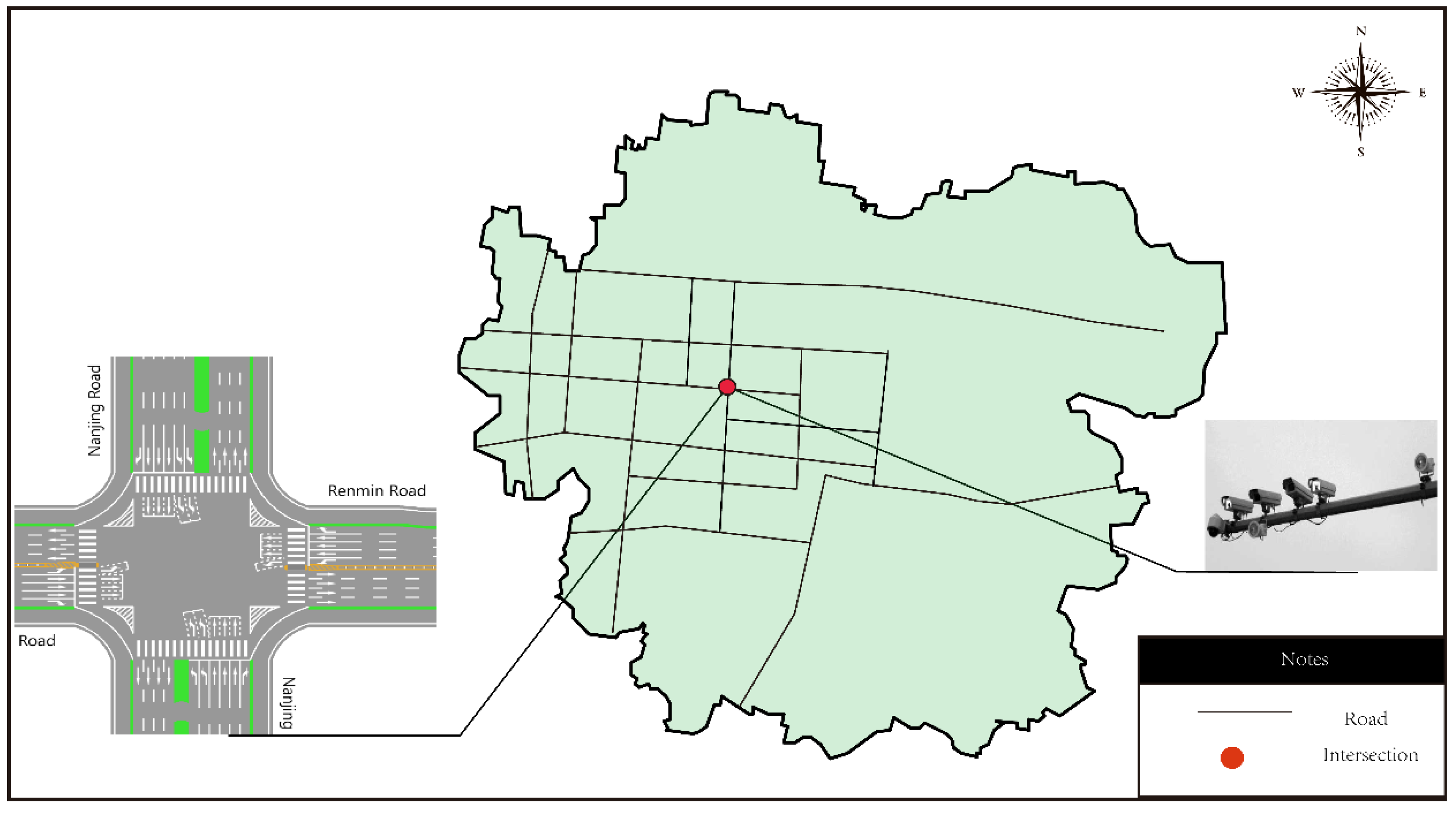
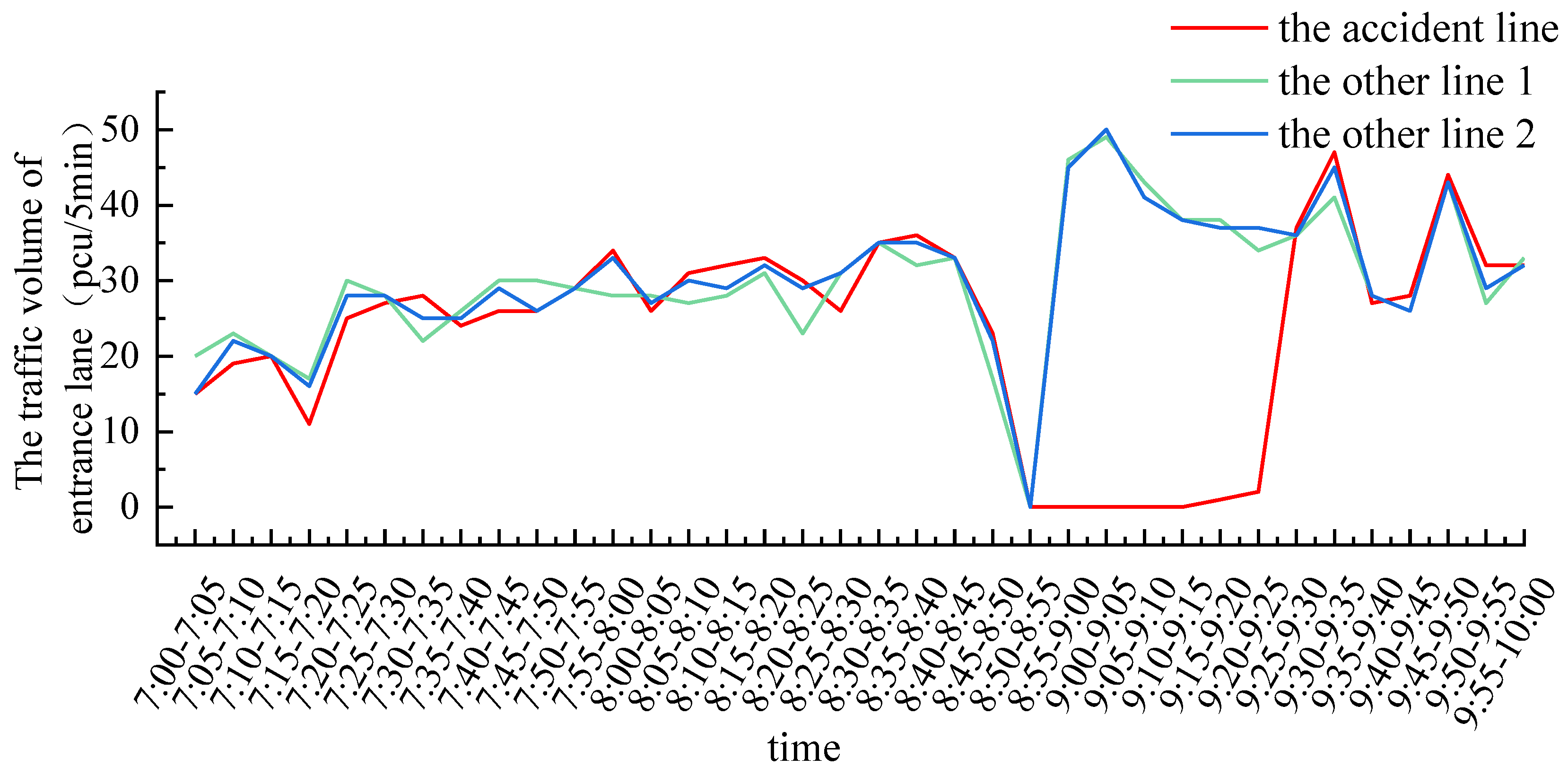
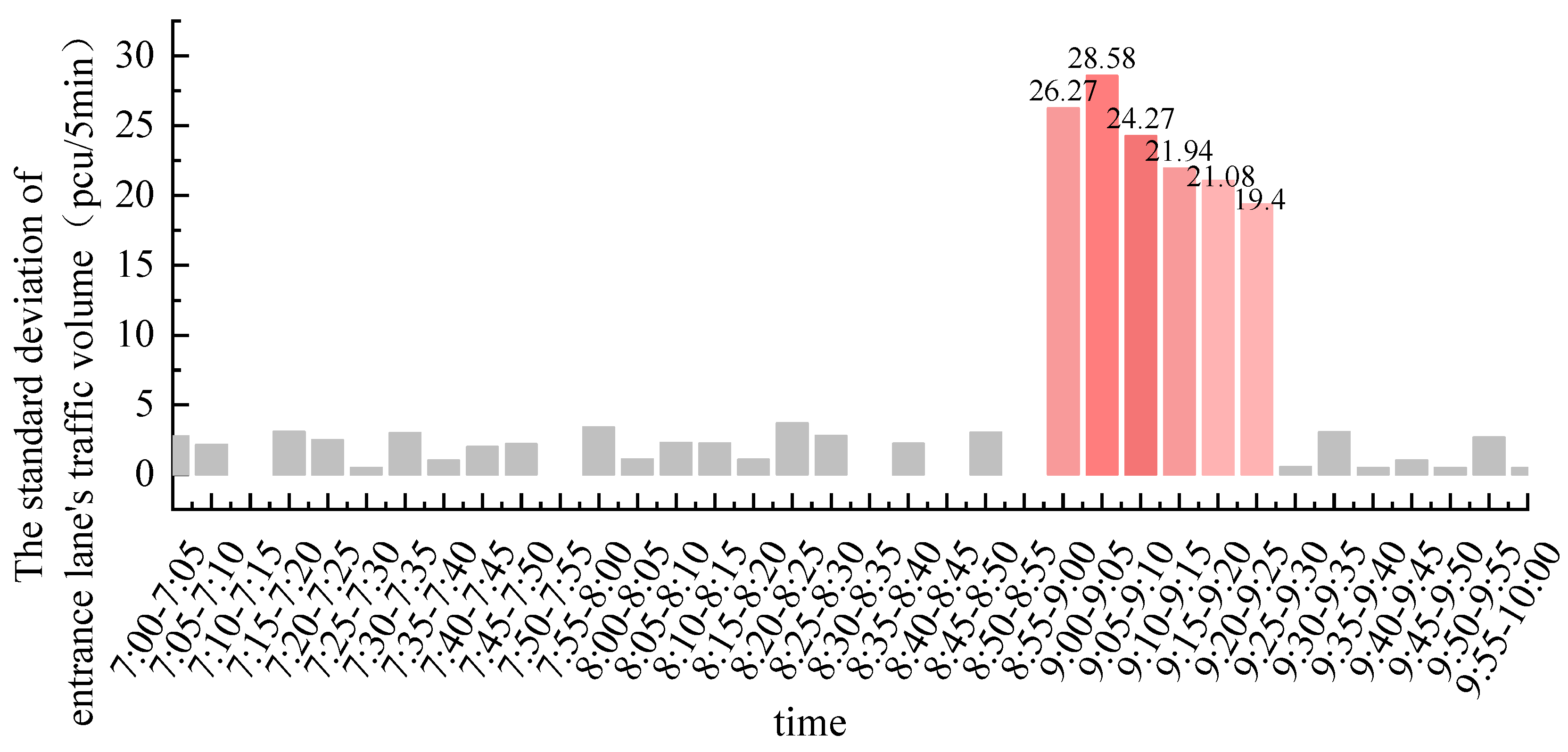
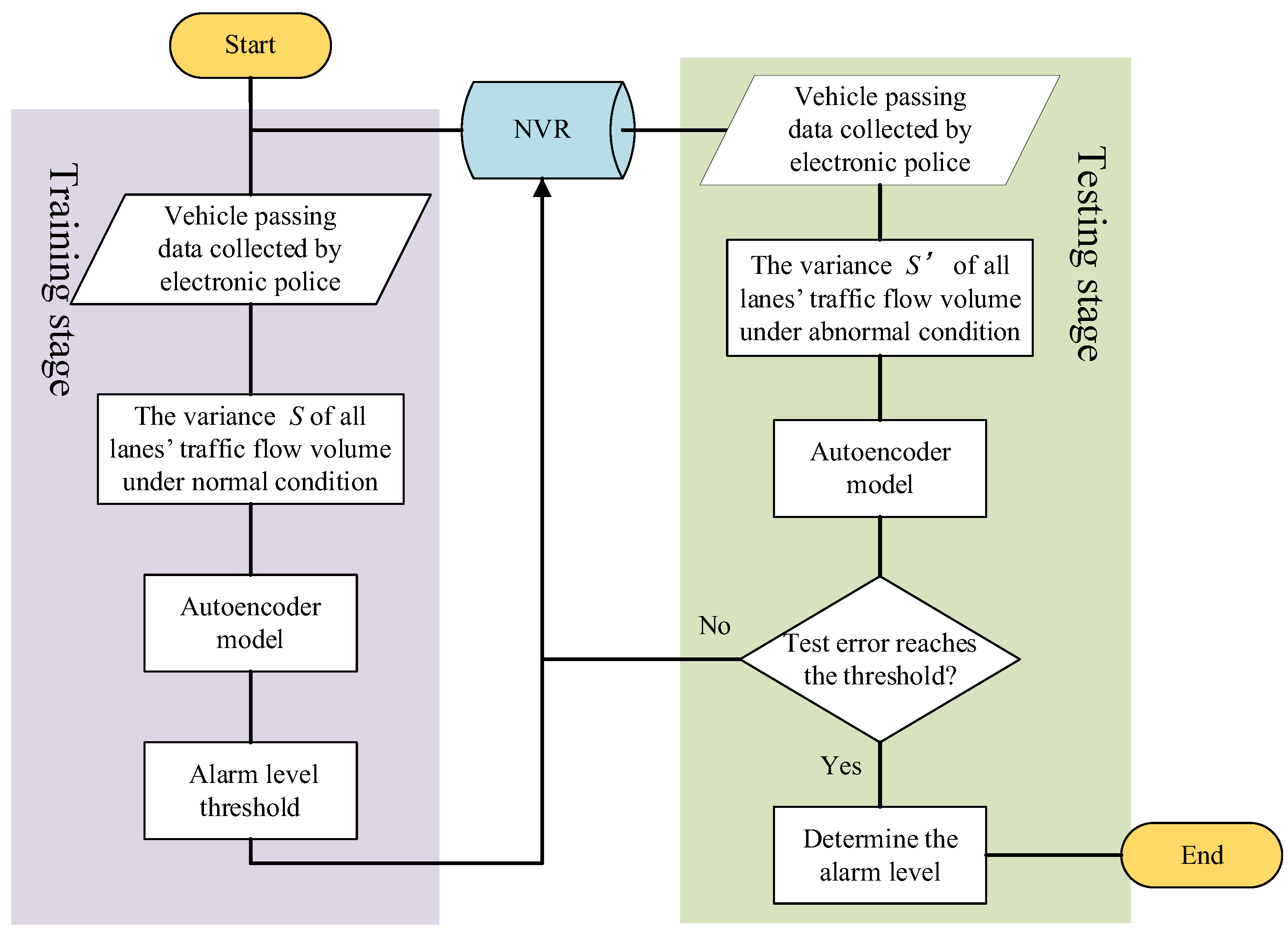
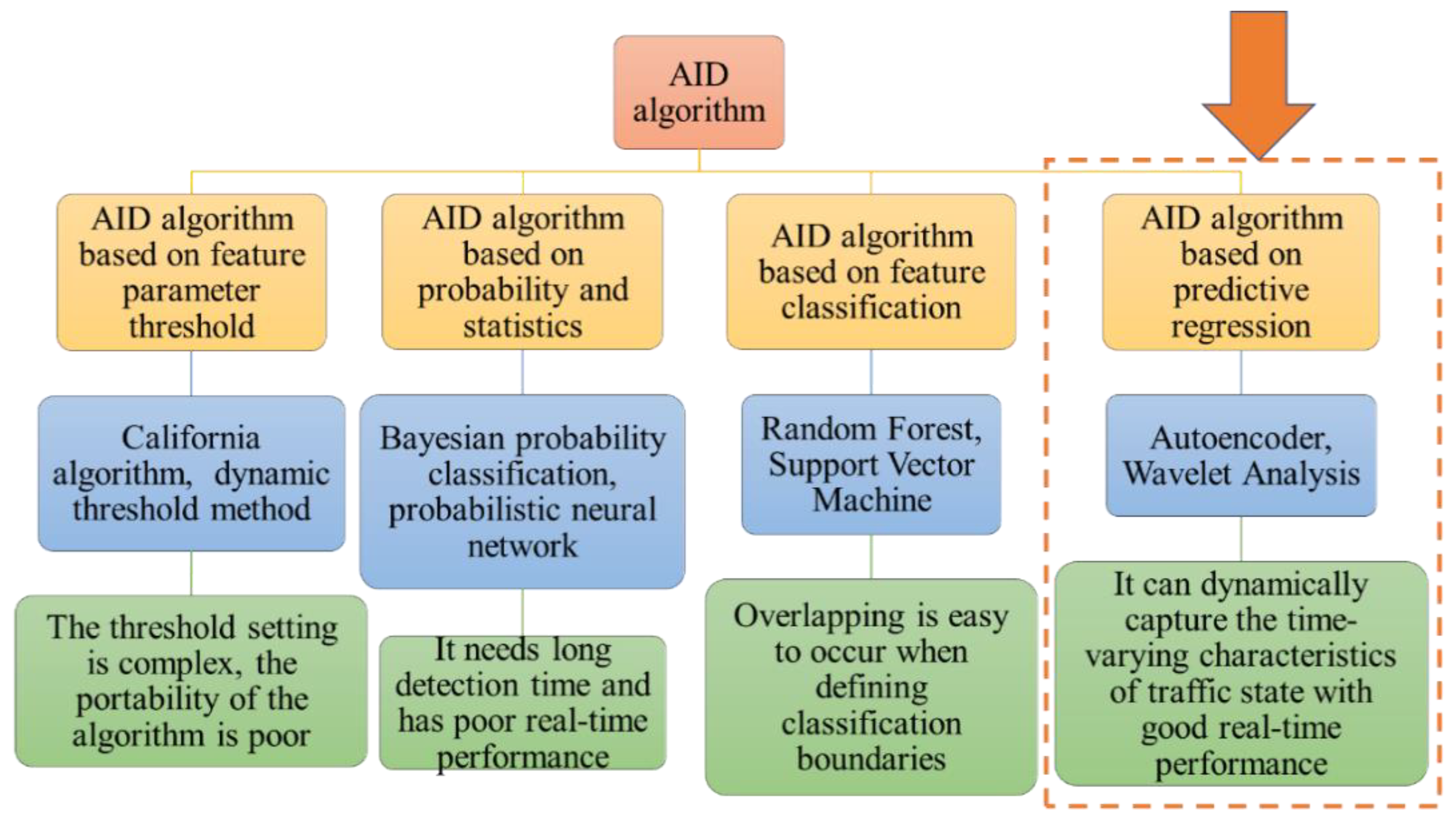
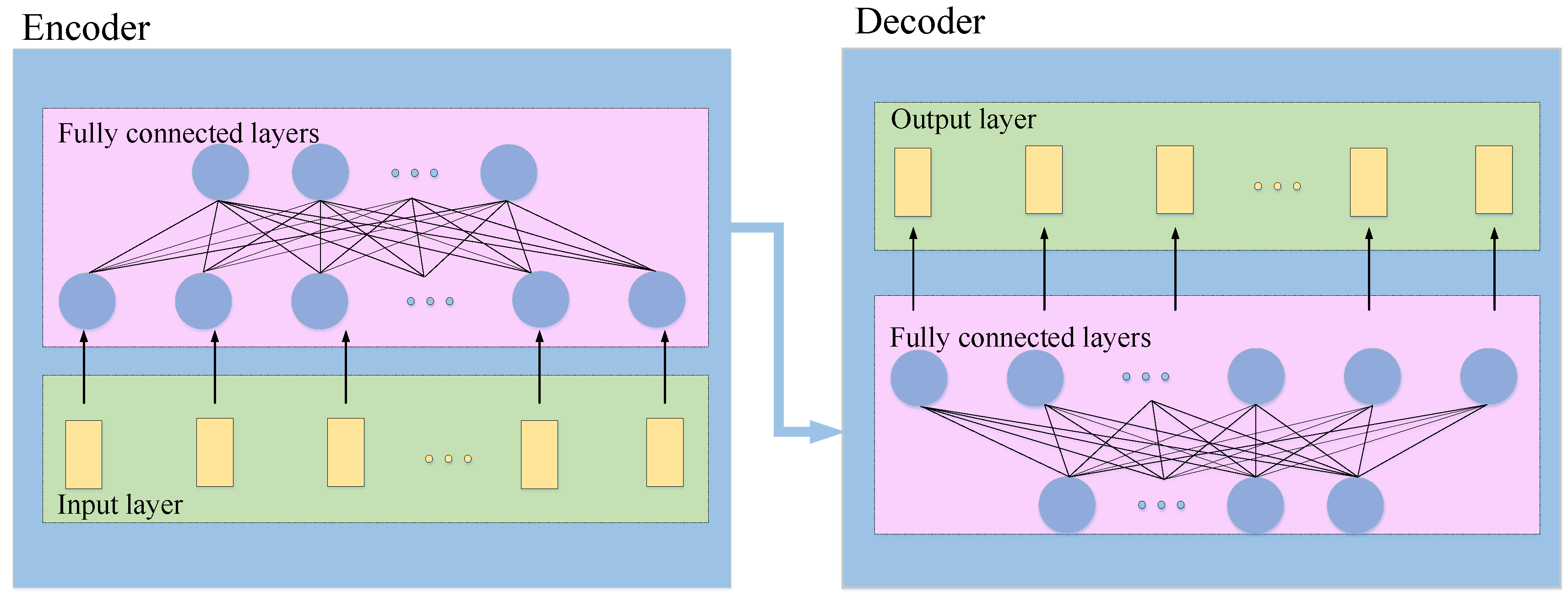
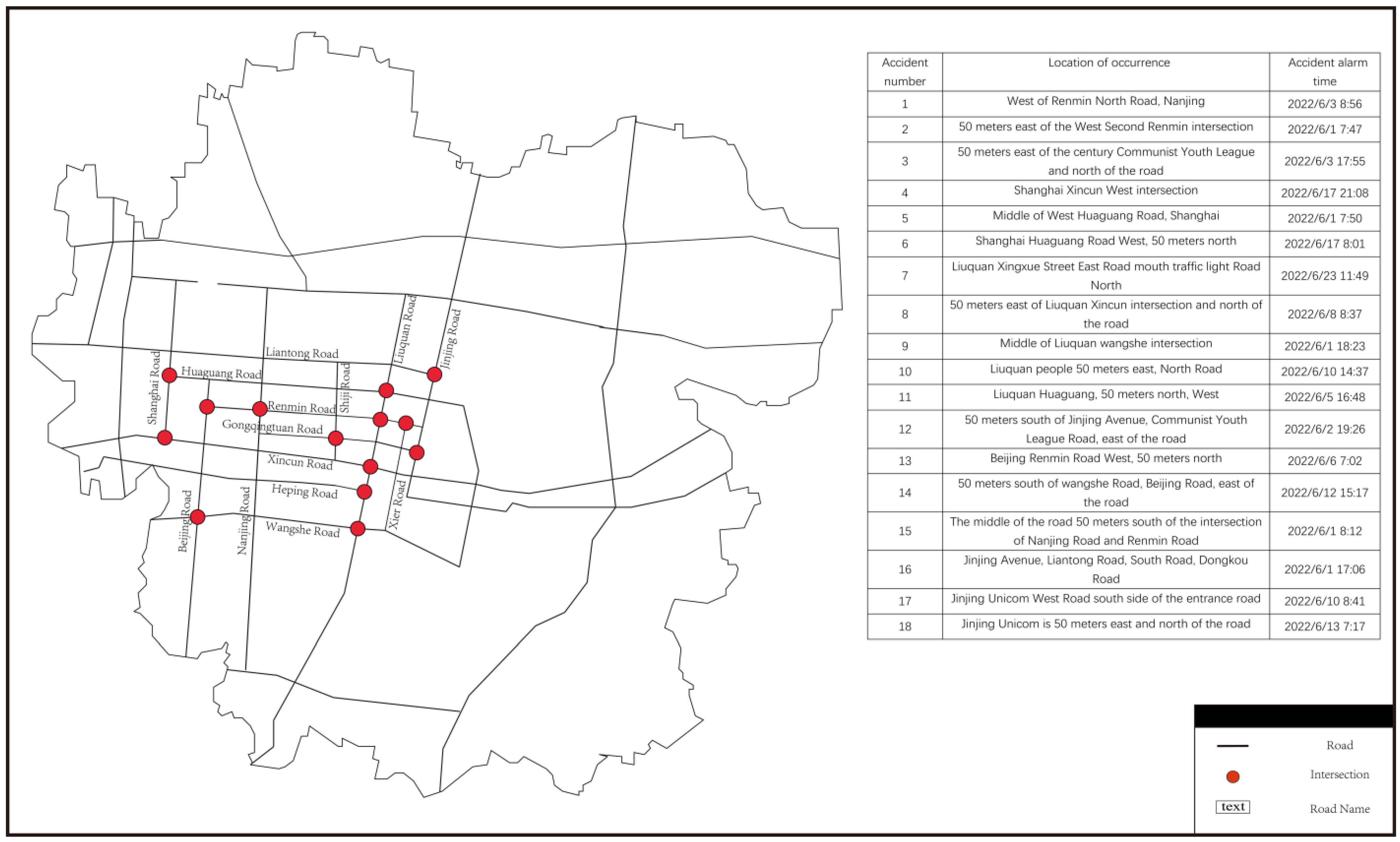


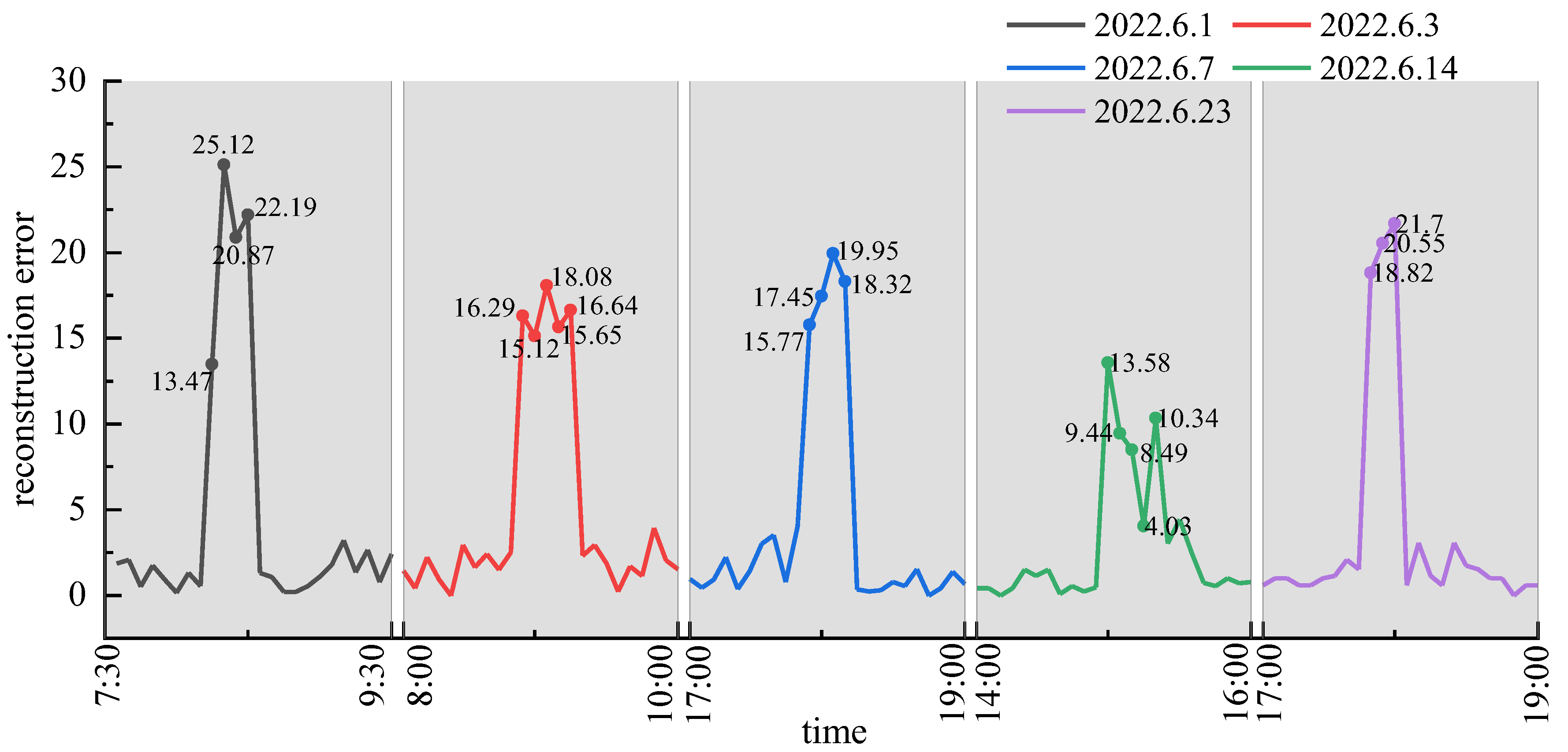
| Car Number | Time | Location | Direction | Lane Number |
|---|---|---|---|---|
| SD C88 *** | 08:48:52, 8 June 2022 | the intersection of Nanjing Rd and Renmin Rd | From north to south | 3 |
| SD CY0 *** | 08:48:51, 8 June 2022 | the intersection of Nanjing Rd and Renmin Rd | From north to south | 2 |
| SD C9X *** | 08:48:50, 8 June 2022 | the intersection of Nanjing Rd and Renmin Rd | From north to south | 5 |
| SD CED *** | 08:48:50, 8 June 2022 | the intersection of Nanjing Rd and Renmin Rd | From north to south | 4 |
| No license plate | 08:48:50, 8 June 2022 | the intersection of Nanjing Rd and Renmin Rd | From north to south | 3 |
| Time (26 May 2022) | Line 1 (pcu/5 min) | Line 2 (pcu/5 min) | Line 3 (pcu/5 min) | Entrance Lanes’ Traffic Volume Every 5 min per Hour (pcu/5 min) |
|---|---|---|---|---|
| 8:10–8:15 | 32 | 28 | 31 | 2.27 |
| 8:15–8:20 | 33 | 31 | 31 | 1.09 |
| 8:20–8:25 | 30 | 23 | 25 | 3.70 |
| 8:25–8:30 | 26 | 31 | 27 | 2.80 |
| 8:30–8:35 | 35 | 35 | 35 | 0.00 |
| 8:35–8:40 | 36 | 32 | 33 | 2.24 |
| Number | Accident Location Intersection | Occurrence Time |
|---|---|---|
| 1 | Nanjing Rd and Renmin Rd (North entrance) | 8:56, 3 June 2022 |
| 2 | West Second Rd and Renmin Rd (East entrance) | 7:47, 1 June 2022 |
| 3 | Shiji Rd and Gongqingtuan Rd (East entrance) | 17:55, 3 June 2022 |
| 4 | Shanghai Rd and Xincun West Rd (South entrance) | 21:08, 17 June 2022 |
| 5 | Shanghai Rd and Huaguang Rd (East entrance) | 7:50, 1 June 2022 |
| 6 | Shanghai Rd and Huaguang Rd (North entrance) | 8:01, 17 June 2022 |
| 7 | Liuquan Rd and Xingxue Street (East entrance) | 11:49, 23 June 2022 |
| 8 | Liuquan Rd and Xincun Rd (East entrance) | 8:37, 8 June 2022 |
| 9 | Liuquan Rd and wangshe Rd (East entrance) | 18:23, 1 June 2022 |
| 10 | Liuquan Rd and Renmin Rd (East entrance) | 14:37, 10 June 2022 |
| 11 | Liuquan Rd and Huaguang Rd (North entrance) | 16:48, 5 June 2022 |
| 12 | Gongqingtuan Rd and Jinjing (Avenue South entrance) | 19:26, 2 June 2022 |
| 13 | Beijing Rd and Renmin Rd (North entrance) | 7:02, 6 June 2022 |
| 14 | Beijing Rd and wangshe Rd (South entrance) | 15:17, 12 June 2022 |
| 15 | Nanjing Rd and Renmin Rd (South entrance) | 8:12, 1 June 2022 |
| 16 | Jinjing Avenue and Liantong Rd (South entrance) | 17:06, 1 June 2022 |
| Period | Mean Value of Error | Standard Deviation of Error | 90% Quantile | 95% Quantile | 99% Quantile |
|---|---|---|---|---|---|
| The morning peak period | 1.3492 | 2.4349 | 4.2 | 6.3 | 12.5 |
| The daylight off-peak period | 1.2653 | 2.0449 | 2.8 | 4.8 | 10 |
| The evening peak period | 1.4129 | 2.4658 | 4.1 | 5.9 | 11.9 |
| Model | AE | RF | SVM | |
|---|---|---|---|---|
| DR (%) | The morning peak period | 94.33 | 89.30 | 90.15 |
| The daylight off-peak period | 81.64 | 78.59 | 80.15 | |
| The evening peak period | 95.47 | 89.52 | 90.01 | |
| FAR (%) | The morning peak period | 5.99 | 20.13 | 19.69 |
| The daylight off-peak period | 12.55 | 22.14 | 20.45 | |
| The evening peak period | 6.56 | 22.67 | 21.43 | |
| MTTD (min) | The morning peak period | 3.96 | 5.23 | 5.44 |
| The daylight off-peak period | 5.29 | 6.59 | 6.34 | |
| The evening peak period | 4.21 | 6.15 | 5.61 | |
Disclaimer/Publisher’s Note: The statements, opinions and data contained in all publications are solely those of the individual author(s) and contributor(s) and not of MDPI and/or the editor(s). MDPI and/or the editor(s) disclaim responsibility for any injury to people or property resulting from any ideas, methods, instructions or products referred to in the content. |
© 2023 by the authors. Licensee MDPI, Basel, Switzerland. This article is an open access article distributed under the terms and conditions of the Creative Commons Attribution (CC BY) license (https://creativecommons.org/licenses/by/4.0/).
Share and Cite
Du, Y.; Sun, F.; Jiao, F.; Liu, B.; Wang, X.; Zhao, P. The Identification of Intersection Entrance Accidents Based on Autoencoder. Sustainability 2023, 15, 8533. https://doi.org/10.3390/su15118533
Du Y, Sun F, Jiao F, Liu B, Wang X, Zhao P. The Identification of Intersection Entrance Accidents Based on Autoencoder. Sustainability. 2023; 15(11):8533. https://doi.org/10.3390/su15118533
Chicago/Turabian StyleDu, Yingcui, Feng Sun, Fangtong Jiao, Benxing Liu, Xiaoqing Wang, and Pengsheng Zhao. 2023. "The Identification of Intersection Entrance Accidents Based on Autoencoder" Sustainability 15, no. 11: 8533. https://doi.org/10.3390/su15118533
APA StyleDu, Y., Sun, F., Jiao, F., Liu, B., Wang, X., & Zhao, P. (2023). The Identification of Intersection Entrance Accidents Based on Autoencoder. Sustainability, 15(11), 8533. https://doi.org/10.3390/su15118533







